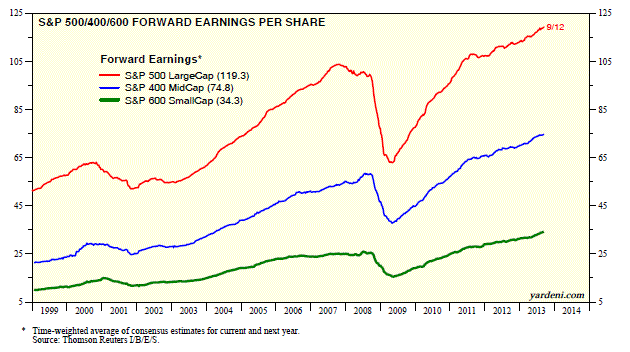
Gold rallied briefly on September 18 when the FOMC decided not to start tapering QE. The rally fizzled quickly. I view gold as an indicator of the underlying trend in commodity prices, particularly of the CRB raw industrials spot price index. This index didn’t rally on the Fed’s decision. It’s been mostly flat this year, and remarkably so since the summer despite mounting signs of better growth in Europe and China.
We recently created a new publication tracking the CRB index versus the stock price indexes and forward earnings of selected MSCI emerging market economies (EMEs). The correlations are mostly very high, especially for the major EME regional indexes, as well as the ones for Brazil, China, Mexico, and South Africa. So far, the CRB index does not confirm the recent rebounds in the EME stock price indexes.
Today's Morning Briefing: Dysfunctional Government. (1) Big Government weighing on global growth. (2) America is exceptional. (3) Halloween is a month early. (4) October can be bad, but a good buying opportunity for yearend rallies. (5) Policy uncertainty suppressing economic growth. (6) Nothing new: Italian government is unstable. (7) Mao is making a comeback in Beijing. (8) Lots of Indian politicians committing crimes. (9) Rising income inequality benefits Big Government most. (10) FSMI soaring, while commodity price index is flat-lining. (11) Earnings expectations very upbeat for 2015. (12) More recovering indicators in Europe. (13) "Rush" (+ +). (More for subscribers.)
We recently created a new publication tracking the CRB index versus the stock price indexes and forward earnings of selected MSCI emerging market economies (EMEs). The correlations are mostly very high, especially for the major EME regional indexes, as well as the ones for Brazil, China, Mexico, and South Africa. So far, the CRB index does not confirm the recent rebounds in the EME stock price indexes.
Today's Morning Briefing: Dysfunctional Government. (1) Big Government weighing on global growth. (2) America is exceptional. (3) Halloween is a month early. (4) October can be bad, but a good buying opportunity for yearend rallies. (5) Policy uncertainty suppressing economic growth. (6) Nothing new: Italian government is unstable. (7) Mao is making a comeback in Beijing. (8) Lots of Indian politicians committing crimes. (9) Rising income inequality benefits Big Government most. (10) FSMI soaring, while commodity price index is flat-lining. (11) Earnings expectations very upbeat for 2015. (12) More recovering indicators in Europe. (13) "Rush" (+ +). (More for subscribers.)































